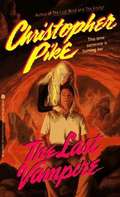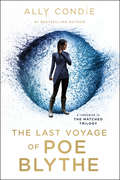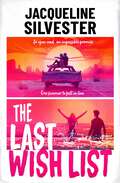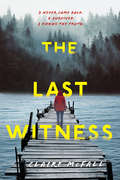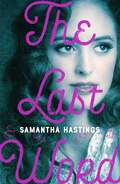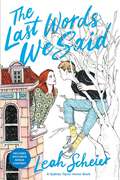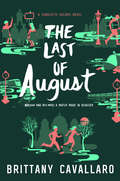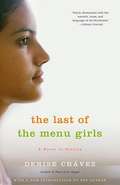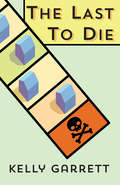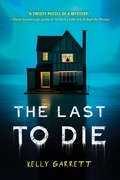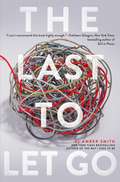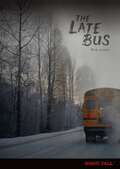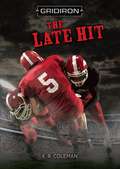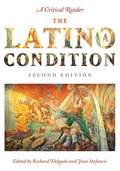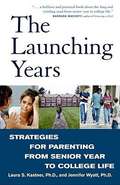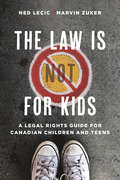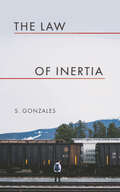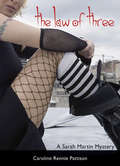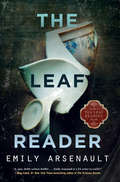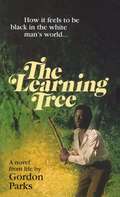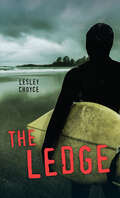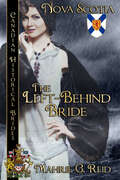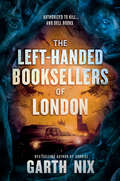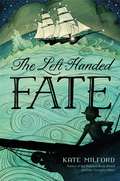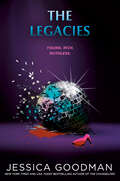- Table View
- List View
The Last Vampire (The Last Vampire #1)
by Christopher PikeFrom a popular spinner of scary tales for young adult readers comes a wonderfully terrifying new novel about Alisa, a 5,000-year-old vampire, who is being hunted by an unknown entity.
The Last Voyage of Poe Blythe
by Ally CondieThe fierce new YA novel from Ally Condie, author of the bestselling Matched trilogy“A compelling, serpentine journey into the heart of grief, the way it can threaten to destroy, and what it looks like to survive.” —Sabaa Tahir, #1 New York Times bestselling author of An Ember in the Ashes “With its wonderful subversion of gender tropes and achingly real characters, The Last Voyage of Poe Blythe takes readers on an epic journey to unearth life’s true treasures. Ally Condie has knocked it out of the park.” —Renée Ahdieh, bestselling author of Smoke in the Sun and The Wrath & the Dawn Who do you become when you have nothing left to lose?There is something Poe Blythe, the seventeen-year-old captain of the Outpost’s last mining ship, wants far more than the gold they tear from the Serpentine River. Revenge. Poe has vowed to annihilate the river raiders who robbed her of everything two years ago. But as she navigates the treacherous waters of the Serpentine and realizes there might be a traitor among her crew, she must also reckon with who she has become, who she wants to be, and the ways love can change and shape you. Even—and especially—when you think all is lost.Ally Condie, the international bestselling author of the Matched trilogy, returns with an intricately crafted and emotionally gripping story of one young woman’s journey to move beyond the grief and anger that control her and find the inner strength to chart her own course.
The Last Wish List: The weepy road trip romance of the summer
by Jacqueline SilvesterDash & Lily meets P.S. I Love You in a life‑affirming rom‑com about seizing your chance and learning to love. Scream into the void Do something that scares you Fall in love . . . ? When Nadia&’s best friend Lizzy dies, she leaves her last wish list – 16 wild and random things to do to help her get over her grief. Every item on the list feels impossible without Lizzy, especially finding a way to meet their favourite megastar.Nadia&’s quest takes her to America where, grieving and alone, she meets Fran, a boy with a big heart and an empty home. Setting out on the road trip of a lifetime along Route 66, the two make an odd couple. But with fate having thrown them together can they help each other find what they&’re looking for? A beautiful, swooning debut following the road trip of a lifetime for fans of You've Reached Sam, Girl in Pieces and John Green, exploring friendship, grief, freedom, and the rush of first love. Praise for The Last Wish List:'The Last Wish List is a beautiful, buoyant roadmap to the heart. I fell in love, cried my heart out, and swooned over Jacqueline Silvester&’s gorgeous prose, and afterward I felt ready to take on the world' Jennifer Niven, bestselling author of All the Bright Places 'Joyful, tender, and achingly romanic, this is a love letter to all the fearless, hopeful, starry-eyed teenage dreamers' Simon James Green, bestselling author of This Book is Gay 'A joyous, swoony road trip that tackles grief, healing and new hope' Wren James, award-winning author of Last Seen Online 'A genuine, compassionate, and deeply-felt exploration of grief and healing. Silvester writes with an open heart about the pain of loss and about the long, sun-drenched, and unexpected road we sometimes have to take to find our way back to hope.' Cecilia Vinesse, author of Seven Days of You 'Heartbreaking and uplifting in equal measure, a beautiful story of friendship, loss and healing.' Amy McCaw, author of Mina and the Undead
The Last Witness
by Claire McFallOne year ago she survived...but being the last one standing has consequences.Heather agrees to go camping with Dougie and his friends because she's desperate to get closer to him, and a secluded beach sounds like the perfect place. But the trip takes a sinister turn that brings Heather's plans to a violent end. One by one, the group begins to vanish. A year later, Heather knows she's just lucky to be alive. And now, people are asking for answers, or else she will be the one to take the blame. A chilling psychological thriller from unflinching and award-winning writer Claire McFall.
The Last Word
by Samantha HastingsSet against the smoky, gaslit allure of Victorian London, this sweetly romantic historical debut is full of humor and stars a whip-smart female heroine ahead of her time.Where one story ends, another begins.1861. Miss Lucinda Leavitt is shocked when she learns the author of her favorite serialized novel has died before completing the story. Determined to learn how it ends, Lucinda reluctantly enlists the help of her father’s young business partner, Mr. David Randall, to track down the reclusive author’s former whereabouts.David is a successful young businessman, but is overwhelmed by his workload. He wants to prove himself to his late father, as well as to himself. He doesn’t have the time, nor the interest, for this endeavor, but Lucinda is not the type to take no for an answer.Their search for the elusive Mrs. Smith and the rightful ending to her novel leads Lucinda and David around the country, but the truths they discover about themselves—and each other—are anything but fictional.Chosen by readers like you for Macmillan's young adult imprint Swoon Reads, The Last Word by debut author Samantha Hastings is a fun yet intellectual romp through Victorian London—the perfect book for book-lovers.Praise for The Last Word:A Junior Library Guild Selection"Witty, spirited, and utterly swoon-worthy. ... Filled with fierce feminism, impeccable period detail, and a charming romance that's sure to stay with readers long after the last word." —Addie Thorley, author of An Affair of Poisons“Great voice. Unique premise. … And who can resist a plucky heroine who is determined to help write an unfinished romance novel by her favorite author!” —B.R. Myers, author of Rogue Princess
The Last Words We Said
by Leah ScheierAll the Bright Places meets If I Stay in this heart-wrenching, romantic novel about a tight-knit group of teen girls coping with a devastating loss and what happens when your best friend is also your first love…and your first heartbreak.Nine months ago, Danny disappeared. His closest friends, Ellie, Rae, and Deenie, are all dealing with the loss differently. Rae&’s pouring herself into rage-baking. Deenie&’s deepening her commitment to Orthodox Judaism. And Ellie—who was Danny&’s girlfriend and closest friend—is the only one who doesn&’t believe he&’s dead. Because she still sees him. In chapters that alternate between past and present, the story of Ellie and Danny unspools—from their serendipitous meeting to Danny&’s effortless absorption into the girls&’ friend group to Danny and Ellie falling for each other. In the past, they were the perfect couple…until it all went wrong. In the present, Ellie&’s looking for answers. She, Rae, and Deenie all have secrets, and they each hold a clue about the night Danny disappeared. Can the friends come together to uncover the truth about Danny? Or will tragedy drive them apart for good?
The Last of August (Charlotte Holmes Novel #2)
by Brittany CavallaroIn the second brilliant, action-packed book in the Charlotte Holmes trilogy, Jamie Watson and Charlotte Holmes are in a chase across Europe to untangle a web of shocking truths about the Holmes and Moriarty families.Jamie and Charlotte are looking for a winter break reprieve in Sussex after a fall semester that almost got them killed. But nothing about their time off is proving simple, including Holmes and Watson’s growing feelings for each other. When Charlotte’s beloved Uncle Leander goes missing from the Holmes estate—after being oddly private about his latest assignment in a German art forgery ring—the game is afoot once again, and Charlotte throws herself into a search for answers. So begins a dangerous race through the gritty underground scene in Berlin and glittering art houses in Prague, where Holmes and Watson discover that this complicated case might change everything they know about their families, themselves, and each other.
The Last of the Menu Girls
by Denise ChávezRocío Esquibel is a girl growing up in a Southern New Mexico town with her mother and sister. She defines her neighborhood by its trees--the willow, the apricot and the one they call the marking-off tree. Rocio knows she was born in the closet where she and her sister now take turns looking at the picture of Jesus whose eyes light up in the dark. But at night she enters a magical realm, and in her imaginary Blue Room, she can fly. At first she is a mesmerized observer of the lives of older girls and their boyfriends, but as she finds a job at the local hospital, and discovers a passion for drama and stories, Rocio begins to make her own choices in love and work. Alive with the taste of tamales and the lyrical tang of the Esquibels' talk, The Last of the Menu Girls becomes a rich celebration of Chicano culture, and a universal story of finding one's way in the world.From the Trade Paperback edition.
The Last to Die
by Kelly GarrettSixteen-year-old Harper Jacobs and her bored friends make a pact to engage in a series of not-quite illegal break-ins. They steal from each other's homes, sharing their keys and alarm codes. But they don't take anything that can't be replaced by some retail therapy, so it's okay. It's thrilling. It's bad. And for Harper, it's payback for something she can't put into words-something to help her deal with her alcoholic mother, her delusional father, and to forget the lies she told that got her druggie brother arrested. It's not like Daniel wasn't rehab bound anyway. So everything is okay-until the bold but aggravating Alex, looking to up the ante, suggests they break into the home of a classmate. It's crossing a line, but Harper no longer cares. She's proud of it. Until one of the group turns up dead, and Harper comes face-to-face with the moral dilemma that will make or break her-and, if she makes the wrong choice, will get her killed.
The Last to Die
by Kelly GarrettIt all started out as a game.Just a way to have fun. We figured as long as we had rules, it wouldn't be a problem.RULE #1: Only break into one another's houses.RULE #2: Only take stuff that can be replaced.It worked for a while. Whoever's turn it was to break in got a rush, and the rest of us laughed over the trophies they brought back. But then someone went too far. Lives got ruined. Someone is dead.And I might be next.
The Last to Let Go
by Amber Smith<P>A twisted tragedy leaves Brooke and her siblings on their own in this provocative new novel from the New York Times bestselling author of The Way I Used To Be. <P>How do you let go of something you’ve never had? <P>Junior year for Brooke Winters is supposed to be about change. <P>She’s transferring schools, starting fresh, and making plans for college so she can finally leave her hometown, her family, and her past behind. <P>But all of her dreams are shattered one hot summer afternoon when her mother is arrested for killing Brooke’s abusive father. <P>No one really knows what happened that day, if it was premeditated or self-defense, whether it was right or wrong. <P>And now Brooke and her siblings are on their own. In a year of firsts—the first year without parents, first love, first heartbreak, and her first taste of freedom—Brooke must confront the shadow of her family’s violence and dysfunction, as she struggles to embrace her identity, finds her true place in the world, and learns how to let go.
The Late Bus (Night Fall ™)
by Richard ReeceLamar takes the "late bus" home from school after practice each day. After the bus's beloved driver passes away, Lamar begins to see strange things—demonic figures, preparing to attack the bus. Soon he learns the demons are after Mr. Rumble, the freaky new bus driver. Can Lamar rescue his fellow passengers, or will Rumble's past come back to destroy them all?
The Late Hit (Gridiron)
by K. R. ColemanWith talk of their high school shutting down for good, Busby and his best friend Anton know that it might be up to their football team to save the school. With such high stakes, is it worth it to ignore injuries and push through? Will a concussion keep Anton—the star quarterback—from playing? Not if he has anything to say about it! Busby is forced to make a difficult decision. . . .
The Latino/a Condition: A Critical Reader (Second Edition)
by Richard Delgado Jean StefancicOffers a broad portrait of Latino/a life in the United States at the beginning of the twenty-first century.
The Launching Years: Strategies for Parenting from Senior Year to College Life
by Laura S. Kastner Jennifer WyattThis guide for parents of teens making the transition from high school to college suggests detailed, practical ways to weather the emotional onslaught of impending separation. From parents experiencing "empty-nest blues" to helping teens avoid the slump of "senioritis, " the authors offer down-to-earth advice to get through this challenging time.
The Law is (Not) for Kids: A Legal Rights Guide for Canadian Children and Teens
by Ned Lecic Marvin A. ZukerIn this practical guide to the law for young people of Canada, Ned Lecic and Marvin Zuker provide an all-encompassing manual meant to empower and educate children and youth and those that serve them. The authors address questions about how rights and laws affect the lives of young people at home, at school, at work, and in their relationships as they draw attention to the many ways in which a person’s life can intersect with the law. Deliberately refraining from taking a moral approach, the authors instead advocate for the rights of children and provide examples of how young people can get their legal rights enforced. In addition to being critical information for youth about citizenship, The Law is (Not) for Kids is a valuable resource for teachers, counsellors, lawyers, and all those who support youth in their encounters with the law.
The Law of Inertia
by S. GonzalesMysteries have a way of gaining momentum.When James’s boyfriend dies by suicide, a foster kid with a checkered past, no one asks too many questions. “Ash always had problems,” they say. But to James, the so-called facts are just the first of many mysteries. And when the very person who can answer his questions skips town, James wonders what else is being hidden. A YA novel of suspense and shifting viewpoints, for readers of Adam Silvera and Gone Girl.
The Law of Three: A Sarah Martin Mystery
by Caroline Rennie-PattisonSarah Martin isn’t the only outsider in her small Muskoka town. But when she’s teamed up with Byron Hopper for a geometry project, she discovers that she’s had an easier time being accepted in her new town than some long-time residents. Byron’s family has long been the subject of rumours. Some say that they are a mob family, some say they are part of a witness relocation program, some say they are just plain weird. But the most sinister rumour surrounds Byron’s sister, Garnet, who many believed committed murder. Sarah resolves to get closer to Byron to find out more about his family … and get to the bottom of the alleged murder. In so doing, she learns that the family has another secret: they’re Wiccans. As Sarah learns more about the family, she also cuts through popular misconceptions about Wicca and finds out what Wiccans believe, how they worship, and what values they hold dear.
The Leaf Reader
by Emily ArsenaultEmily Arsenault (The Rose Notes) makes her YA debut with a “page-ripping whodunit” about Marnie Wells, who comes face-to-face with the occult when she discovers her ability to read tea leaves might help solve the mystery of a classmate's disappearance.Marnie Wells knows that she creeps people out. It’s not really her fault; her brother is always in trouble, and her grandmother, who’s been their guardian since Mom took off is . . . eccentric. So no one even bats an eye when Marnie finds an old book about reading tea leaves and starts telling fortunes. The ceremony and symbols are weirdly soothing, but she knows—and hopes everyone else does too—that none of it’s real.Then basketball star Matt Cotrell asks for a reading. He’s been getting emails from someone claiming to be his best friend, Andrea Quinley, who disappeared and is presumed dead. And while they’d always denied they were romantically involved, a cloud of suspicion now hangs over Matt. But Marnie sees a kindred spirit: someone who, like her, is damaged by association.Suddenly, the readings seem real. And, despite the fact that they’re telling Marnie things about Matt that make him seem increasingly dangerous, she can’t shake her initial attraction to him. In fact, it’s getting stronger. And that could turn out to be deadly.
The Learning Tree
by Gordon ParksPhotographer, writer, and composer, Gordon Parks has written a moving, true-to-life novel of growing up as a black man in this country in the 1900s. Hailed by critics and readers alike, The Learning Tree tells the extraordinary journey of a family as they struggle to understand the world around them and leave their mark a world that is better for their having been in it.
The Ledge (Orca Soundings)
by Lesley ChoyceNick was used to being good at everything. Hockey, football, track, they all came easy to him. Surfing was his latest passion. That is, until the accident. Now partially paralyzed, Nick is angry, depressed and getting far too fond of his prescription meds. But his frequent visits to his physiotherapist, a Syrian refugee, and a budding friendship with a partial amputee who has also experienced firsthand the horrors of war help him start to piece his life back together. A story about overcoming the odds and changing your life for the better.
The Left Behind Bride: Canadian Historical Brides (Canadian Historical Brides #10)
by ReidMaggie Conrad’s husband of ten days is sent overseas in WW1 and never comes home. A second suitor is lost at sea in Nova Scotia’s August Gale. Turning thirty, and on her own, she resolves to make a life for her herself and her younger brother, Ivan.
The Left-Handed Booksellers of London
by Garth NixA girl’s quest to find her father leads her to an extended family of magical fighting booksellers who police the mythical Old World of England when it intrudes on the modern world. From the bestselling master of teen fantasy, Garth Nix.In a slightly alternate London in 1983, Susan Arkshaw is looking for her father, a man she has never met. Crime boss Frank Thringley might be able to help her, but Susan doesn’t get time to ask Frank any questions before he is turned to dust by the prick of a silver hatpin in the hands of the outrageously attractive Merlin.Merlin is a young left-handed bookseller (one of the fighting ones), who with the right-handed booksellers (the intellectual ones), are an extended family of magical beings who police the mythic and legendary Old World when it intrudes on the modern world, in addition to running several bookshops.Susan’s search for her father begins with her mother’s possibly misremembered or misspelt surnames, a reading room ticket, and a silver cigarette case engraved with something that might be a coat of arms.Merlin has a quest of his own, to find the Old World entity who used ordinary criminals to kill his mother. As he and his sister, the right-handed bookseller Vivien, tread in the path of a botched or covered-up police investigation from years past, they find this quest strangely overlaps with Susan’s. Who or what was her father? Susan, Merlin, and Vivien must find out, as the Old World erupts dangerously into the New.
The Left-handed Fate
by Kate Milford Eliza WheelerReturn to Nagspeake for a new fantasy adventure from the bestselling author of National Book Award nominee Greenglass House.<P><P> Lucy Bluecrowne and Maxwell Ault are on a mission: find the three pieces of a strange and arcane engine they believe can stop the endless war raging between their home country of England and Napoleon Bonaparte’s France. During the search, however, their ship, the famous privateer the Left-Handed Fate, is taken by the Americans, who have just declared war on England, too. The Fate (and with it, Lucy and Max) is put under the command of new midshipman Oliver Dexter... who’s only just turned twelve.<P> But Lucy and Max aren’t the only ones trying to assemble the engine; the French are after it, as well as the crew of a mysterious vessel that seems able to appear out of thin air. When Oliver discovers what his prisoners are really up to―and how dangerous the device could be if it falls into the wrong hands―he is faced with a choice: Help Lucy and Max even if it makes him a traitor to his own country? Or follow orders and risk endangering countless lives, including those of the enemies who have somehow become his friends?
The Legacies
by Jessica Goodman"Our new favorite thriller." – COSMOPOLITAN A glitzy YA thriller set in New York City elite social circles, filled with backstabbing and blackmail, twisty secrets, and a dead body, from New York Times bestselling author Jessica Goodman.Perfect for fans of Euphoria, Holly Jackson, and Jessica Knoll.An invitation for membership to the exclusive Legacy Club in New York City is more than an honor. It gives lifetime access to power and wealth beyond any prep school doors, as Legacy Club members always look out for their own. That is, after you make it through a rigorous week of events and the extravagant gala, the Legacy Ball.It&’s not surprising when Excelsior Prep seniors Bernie Kaplan, Isobel Rothcroft, and Skyler Hawkins are nominated as Legacies; their family pedigrees have assured their membership since birth—even if they're all keeping secrets that could destroy their reputations. But scholarship kid from Queens Tori Tasso is the surprise nominee no one saw coming. She&’s never fit in this world of designer bags, penthouse apartments, and million-dollar donations. So what did she do to secure her place?The evening of the Legacy Ball arrives, and everyone expects a night of luxury and excess, haute couture, and plenty of hushed gossip.No one expects their secrets to come out.Or for someone to die trying to keep them hidden.
